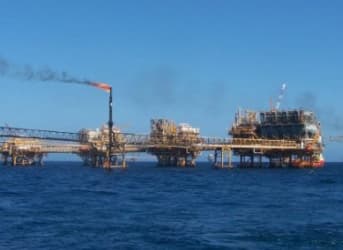The oil industry is betting big on the Gulf of Mexico with both costs and production rising as a result.
The Gulf has seen a bit of a resurgence in production this year, after declining from a peak in 2009. The oil industry extracted 1.7 million barrels per day on average in the summer of 2009, which fell to 1.2 million barrels per day last year (see chart. Data from EIA).
But oil output is up around 15% since then, as the industry pours billions of dollars into the Gulf. The Wall Street Journal reported that several new projects from Royal Dutch Shell, Hess Corporation, ExxonMobil and Chevron are expected to come online before the end of 2015 and will have a combined production capacity of 900,000 barrels per day.

The production gains come with high price tags. Since 2010, deepwater wells have seen costs balloon by 25%, according to the WSJ. The average deepwater well can cost $300 million. Even worse, costs are rising by 5 to 10 percent each year.
Related: Subsea Production: The Next Big Trend In Offshore Drilling
Some of that has to do with the fact that drillers have to move further offshore and into deeper waters. But additional safety regulations that came in the wake of the BP Deepwater Horizon disaster have also added to project costs. The WSJ notes that the average deepwater well takes 13% longer to drill compared to pre-Deepwater Horizon projects due to more scrutiny from inspectors.
There are some exceptions to the trend. On November 16, Hess announced that its joint project with Chevron – Tubular Bells – came online. By the end of the year, Tubular Bells is expected to ramp up production to 50,000 barrels per day. The project became operational just three years after it got the green light, and was completed on budget.
Building on their success, Hess and Chevron plan to invest a combined $6 billion in another project in an effort to bring a further 80,000 bpd online.
Chevron also announced a new deepwater discovery in October. The company’s Guadalupe prospect showed promising signs of oil, but further tests are needed to appraise the extent of the reserves.
Chevron’s discovery is interesting, because while the discovery is good news on its face, the project is also illustrative of the rising costs of exploration. The oil is found in the Lower Tertiary – a layer of the earth’s crust that is ultra-deep, has high sand content, and is extremely expensive to drill. Oil companies are looking at this layer because shallower fields are harder to come by.
Still, the industry is optimistic about the Gulf because oil fields tend to be bigger and come with more sustainable production rates compared to the onshore shale fields that are driving most of the American oil boom. Offshore wells produce for decades while the average shale well declines precipitously after its first few years in operation.
Related: How Oil Platforms Increase Fish Populations
Also, there could be as much as three to four times more oil – potentially 48 billion barrels of undiscovered oil are believed to be in the Gulf of Mexico, compared to just 13 billion onshore.
With the high levels of investment, oil production is expected to rise to 1.9 million barrels by 2016, according to Wood Mackenzie. That would set a new record high for the Gulf. “We expect production from 2014 to 2016 to grow 18% annually,” Imran Khan, an analyst at Wood Mackenzie, said in a statement.
ADVERTISEMENT
But from there, production could peak, plateau at around 1.9 million barrels per day through 2021, and then enter into a period of decline due to a lack of new discoveries and aging fields.
Further complicating matters is the current period of low oil prices. Wood Mackenzie notes that its prediction that Gulf production can be sustained 1.9 million barrels per day through the end of the decade will only come to pass if the oil industry maintains high levels of investment. But if oil prices stay low, the industry could trim its exploration budget.
For now, oil majors are rushing back into the Gulf.
By Nick Cunningham of Oilprice.com
More Top Reads From Oilprice.com:
- Gulf Of Mexico Deepwater Reserves May Have Been Overestimated
- Exxon Chief Says U.S. Oil Export Ban No Longer Necessary
- Big Oil And Renewables: Not So Strange Bedfellows

















